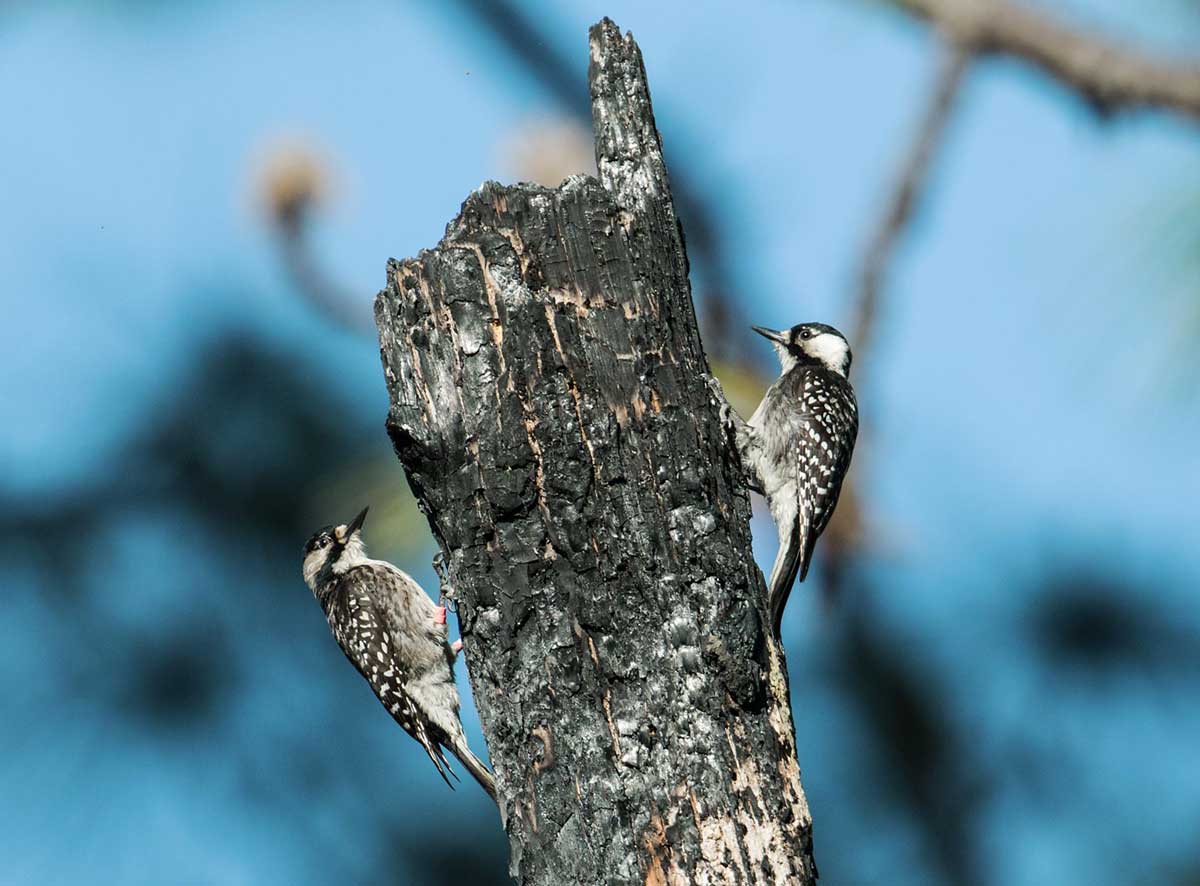
Red-cockaded woodpeckers photo by Nick Athanas.
By Jessica Ruthenberg, Watchable Wildlife Biologist, Virginia Department of Game & Inland Fisheries
The Virginia Department of Game & Inland Fisheries (DGIF) is thrilled to share big news for a federally endangered species in Virginia; a pair of red-cockaded woodpeckers has moved in to Big Woods Wildlife Management Area (WMA) in Sussex County. This is the first documented occurrence of red-cockaded woodpeckers residing on the WMA. The woodpecker species gets its name from a rarely visible small streak of red, called a “cockade” found on each side of the male’s head. The woodpeckers have built roosting cavities in one of the pine trees at Big Woods WMA, a process that takes the birds several months to years to accomplish because they excavate their roosting and nesting cavities strictly in living pine trees, as opposed to dead or decaying trees like other woodpeckers. The woodpeckers’ time invested in settling in at Big Woods WMA indicates that they are there to stay. Both the male and female woodpecker are banded and originated from The Nature Conservancy’s Piney Grove Preserve, which neighbors Big Woods WMA. The Preserve has long harbored the sole remaining population of red-cockaded woodpeckers in Virginia (a second population is being re-established in the Great Dismal Swamp National Wildlife Refuge by DGIF and partners since 2015).
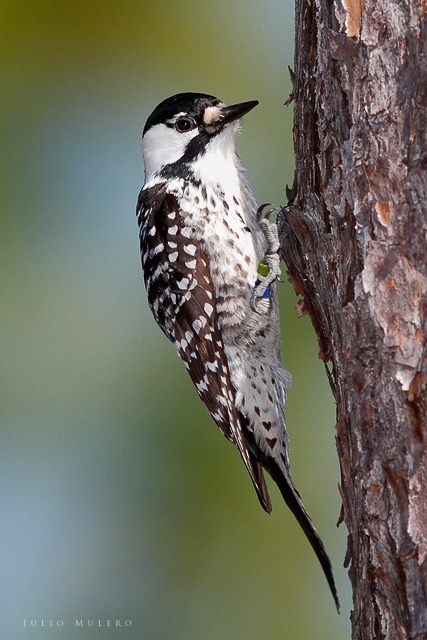
Red-cockaded woodpecker photo by Julio Mulero.
The arrival of these red-cockaded woodpeckers at the WMA marks a major landmark in the DGIF’s conservation efforts for this endangered species. Under the Endangered Species Act, the DGIF has a Cooperative Agreement with the U.S. Fish and Wildlife Service to serve as the lead agency for the conservation of protected animal species in Virginia, including red-cockaded woodpecker. “Through our contributions of funding, equipment and staff time, DGIF has long supported the great conservation work that our partners have done on the Piney Grove population of red-cockaded woodpeckers,” says Sergio Harding, Bird Conservation Biologist with the DGIF. “In recent years we have become more directly involved in such work through habitat management to benefit the species on Big Woods WMA–it is gratifying to see this work start coming to fruition.”
The Road to Recovery
The DGIF has long supported the Center for Conservation Biology’s (CCB) intensive red-cockaded woodpecker population monitoring at Piney Grove Preserve. According to CCB’s surveys, from 2002-2017, the woodpeckers’ population at the Preserve increased from 20 to 84 individuals and the number of family groups increased from 3 to 13 (individual red-cockaded woodpeckers live in family groups consisting of one breeding pair and one or more helpers). This population growth and increase in family groups marked major milestones in Virginia’s red-cockaded woodpecker recovery efforts. However, as the woodpecker population has grown at the Preserve, the birds have begun to run out of space. “Management efforts at Piney Grove have been so successful that the woodpecker population is now bumping up against the limits of what the property will hold – there is simply not sufficient habitat to facilitate our growing the number of woodpecker groups,” says Harding.
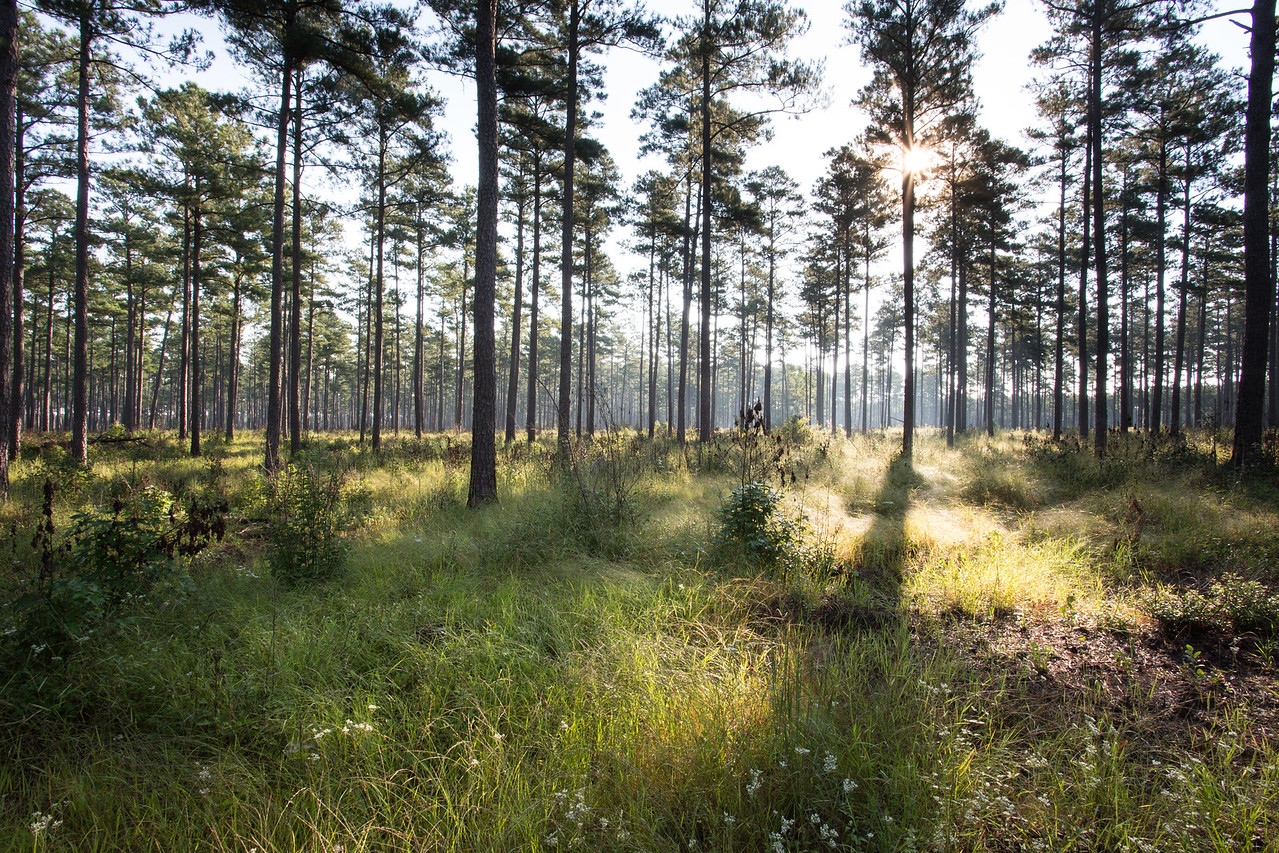
Pine Savanna Habitat at Piney Grove Preserve. Photo by Robert B. Clontz, The Nature Conservancy.
With this in mind, the DGIF acquired Big Woods WMA in 2010 in order to facilitate the expansion of the neighboring Piney Grove Preserve population. The purchase was supported in part with a U.S. Fish and Wildlife Service Recovery Land Acquisition grant award, a program directed at the conservation of habitat for endangered and threatened species, in this instance, red-cockaded woodpeckers. Since then, the DGIF has been working hard to restore the WMA to the habitat required by red-cockaded woodpeckers, called a pine savanna. Pine savannas are open woodlands containing widely spaced pine trees and a lush groundcover of diverse grasses and wildflowers. This restoration has been preparation for the hopeful, eventual arrival of the endangered woodpeckers, but in the meantime, it has also benefited numerous other bird species such as Northern bobwhite and wild turkey.
One of the most critical restoration efforts by the DGIF has been reintroducing fire to this forest, which historically played an essential role in shaping pine savannas. The agency burns units on the WMA every two to three years. To further aid in the restoration process at Big Woods WMA, DGIF has also strategically thinned trees and planted longleaf pines, the pine species preferred by red-cockaded woodpeckers and the historically dominant tree of Virginia’s pine savannas. The arrival of these woodpeckers in Big Woods WMA demonstrates that the DGIF’s restoration efforts are making a difference and Piney Grove Preserve’s woodpeckers are finding the expanded habitat they need. “We’re excited to see our work on the ground pay off,” says Stephen Living, the Lands & Facilities Manager overseeing DGIF’s habitat work at Big Woods. “Over the last six years, our efforts have really accelerated and you can see the difference in the habitat. We are accomplishing critical habitat work for red-cockaded woodpecker and countless other species like turkey, quail and neotropical migrants.”

DGIF Land Manager Stephen Living working a prescribed burn at Big Woods WMA. Photo by Matt Kline/DGIF.
Looking Ahead
Now that spring has begun, the DGIF is hopeful this pair of woodpeckers will breed. Breeding may occur in April, which would result in nestlings hatching in May. To support this pair, and any future additional red-cockaded woodpeckers settling into the WMA, the DGIF plans to continue the prescribed burning and forest thinning program. Additionally, the DGIF has begun supplementing the pair’s natural cavities (which can take the birds years to excavate) with artificial cavities created through drilling and the use of insert boxes. These ready-to-use, artificial cavities are a proven technique to encourage red-cockaded woodpecker population growth.
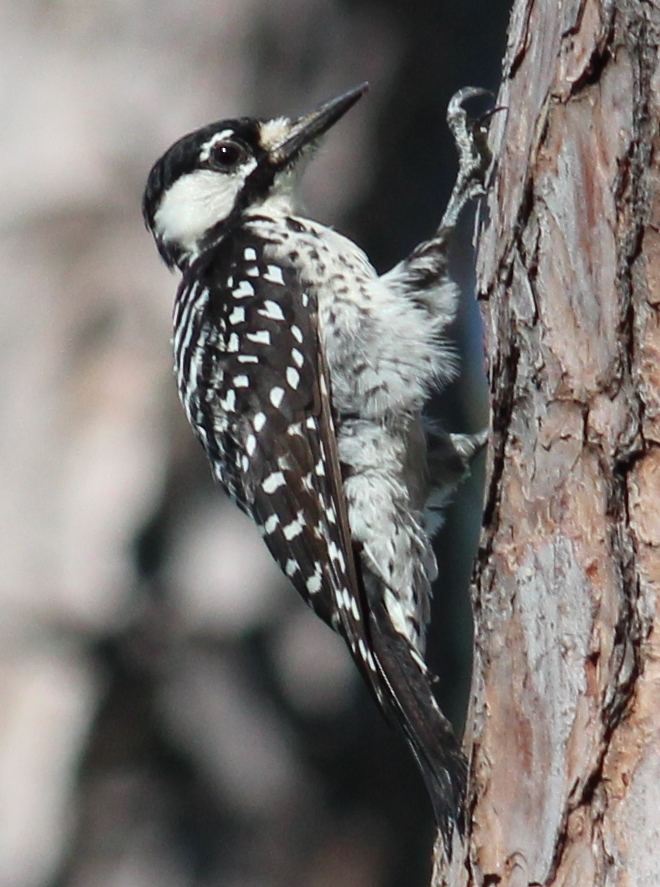
Red-cockaded woodpecker photo by Tom Benson.
So long as the DGIF continues its efforts to maintain Big Woods WMA as a pine savanna, habitat for the red-cockaded woodpecker will only continue to improve. The birds rely on mature pine savannas with pines aging 70-120 years old, but most of the WMA’s pine trees, outside the area the birds currently inhabit, are still relatively young. As the WMA’s pines age with the proper continued management, the DGIF is optimistic that nesting opportunities for the birds will expand to support this growing population of red-cockaded woodpeckers.
To learn more about red-cockaded woodpeckers and their history in Virginia, visit their new species profile on the DGIF website.
Visiting Big Woods WMA
The arrival of the red-cockaded woodpecker to Big Woods WMA is big news for bird conservation and it is also big news for birders. Big Woods WMA is the only location in Virginia with public access to view this rare bird. (Although the woodpeckers are also present at Piney Grove Preserve and Great Dismal Swamp National Wildlife Refuge, they do not inhabit their publicly accessible areas.) To welcome birders and anyone seeking a glimpse of the red-cockaded woodpecker pair, the DGIF will maintain a mowed path, marked with wayfinding signs, leading to a cleared viewing area where visitors may observe the woodpeckers and their cavities. Interpretive signs at each end of the path educate visitors about red-cockaded woodpecker and the DGIF’s conservation work at Big Woods WMA. Also newly installed and soon to be open for public use, is a small parking area at the path entrance. Binoculars and spotting scopes are recommended for the best look at the woodpeckers.
Visitors to the WMA may have already noticed that the DGIF has posted orange, no-trespassing signs marking the red-cockaded woodpeckers’ territory boundaries. To help these endangered birds, all WMA visitors must heed this signage by staying out of the marked boundaries (the exception being hunters who are retrieving game). Additionally, please note that use of audio recordings to call the red-cockaded woodpeckers is strictly forbidden.
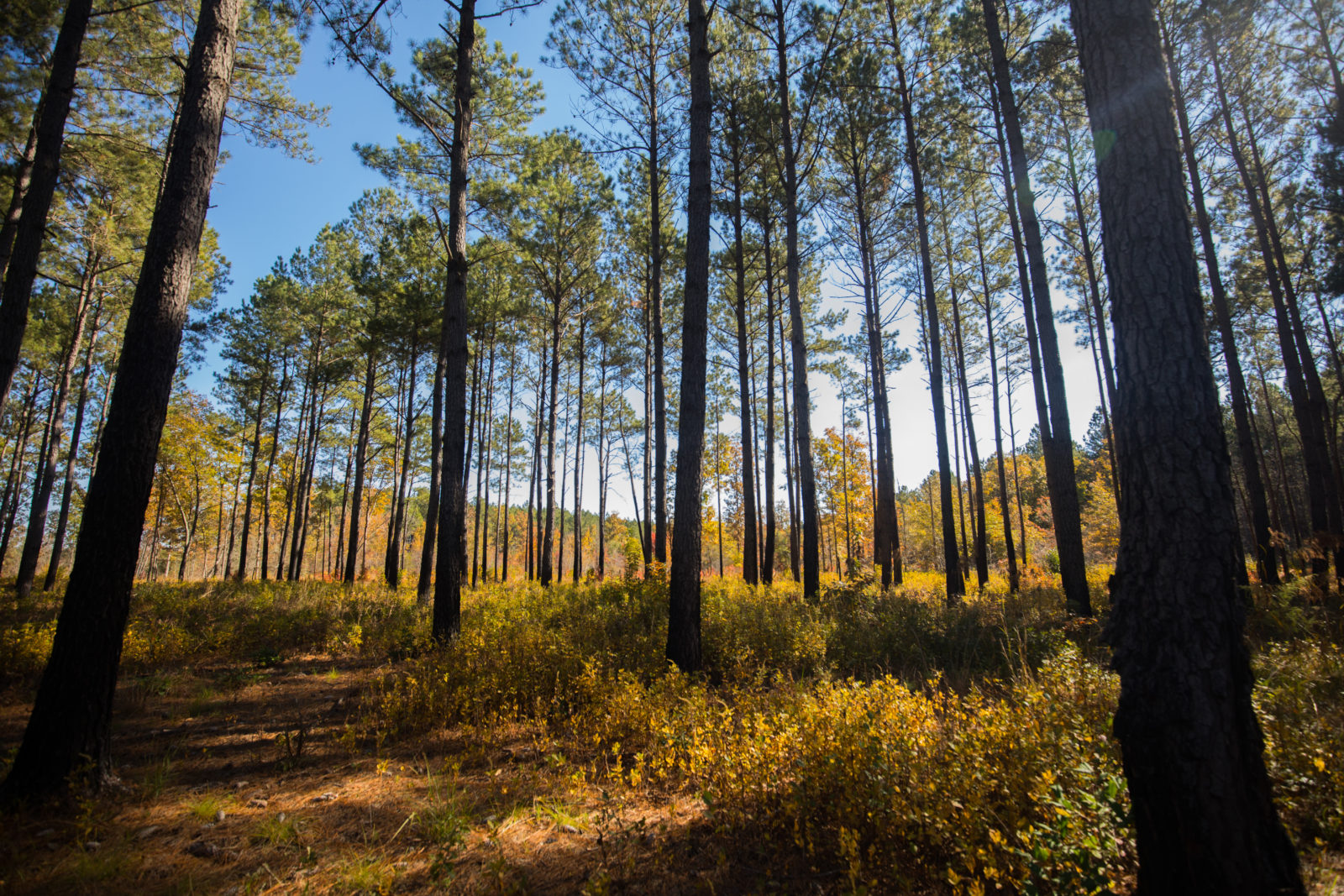
Big Woods WMA. Photo by Meghan Marchetti/DGIF.
Big Woods WMA is a designated site on the Virginia Bird & Wildlife Trail (VBWT). Directions to the red-cockaded woodpecker viewing area, along with additional birding and wildlife viewing information for the WMA, are available on the VBWT’s Big Woods WMA webpage.
To visit the WMA, you must hold a Restore the Wild Membership, a Virginia hunting or fishing license, boat registration, or access permit, all of which can be purchased online at GoOutdoorsVirginia.com or by calling 1-866-721-6911. If visiting the WMA during hunting seasons (April 1 – May 31 and September 1 – February 28), the DGIF strongly advises to wear blaze orange or blaze pink. The DGIF also asks visitors to, “pardon our mess,” while we continue to improve habitat for the red-cockaded woodpeckers. Timber harvests are in process, which is part of our on-going strategic tree thinning program to restore the area to pine savanna habitat.
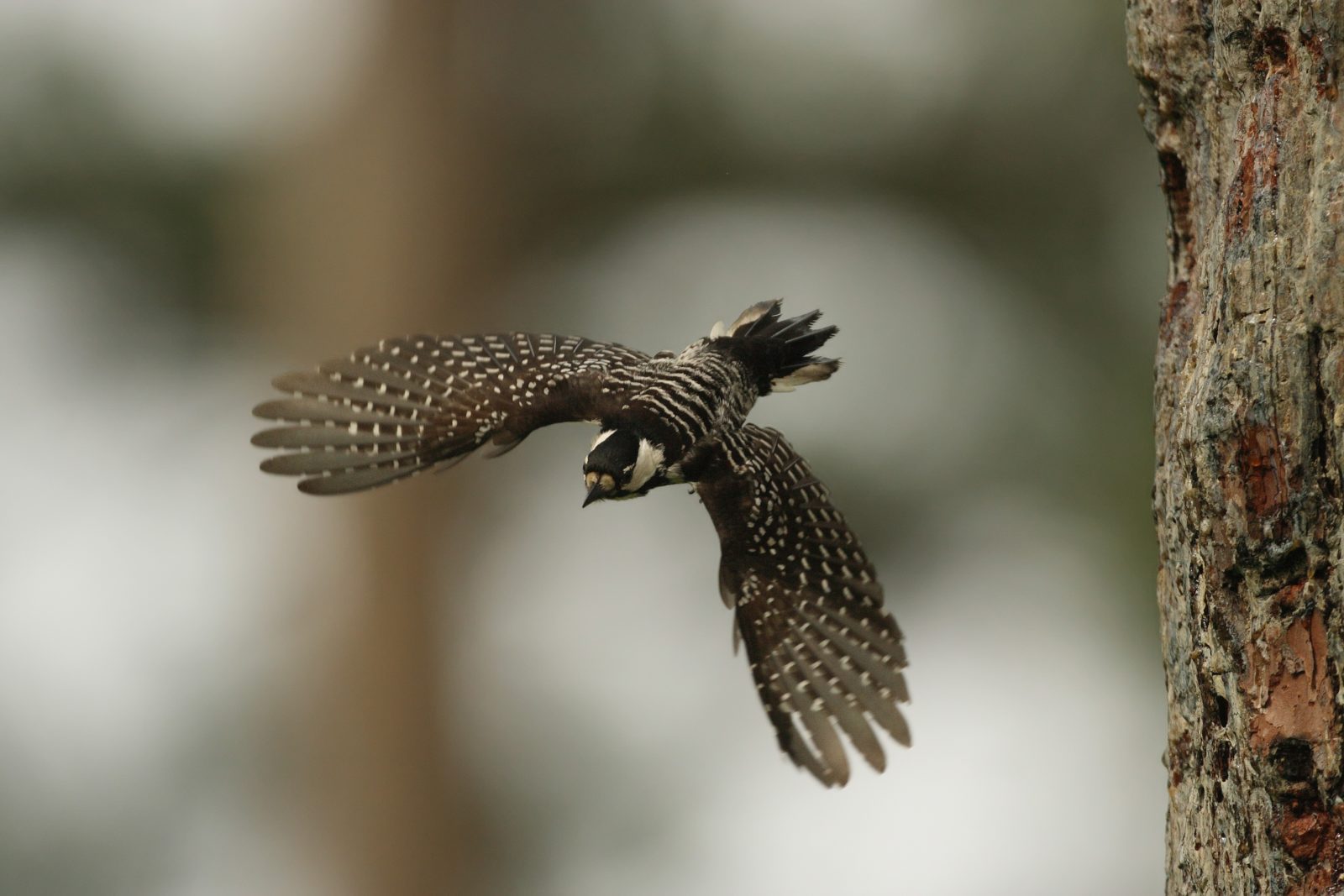
Red-cockaded woodpecker flying from its nest cavity. Photo by Martjan Lammertink, U.S. Forest Service.
How to Support Red-cockaded Woodpeckers in Virginia

- Purchase a Restore the Wild Membership to support the DGIF’s habitat restoration work, such as that accomplished at Big Woods WMA. The membership also serves as your pass to visiting Big Woods WMA and over 40 other WMAs throughout the Commonwealth.
- Donate to the DGIF’s Non-Game Fund to support research and conservation of Virginia’s Species of Greatest Conservation Need, like the red-cockaded woodpecker, as well as conservation education and wildlife viewing recreation.
- Consider participating in a Safe Harbor Agreement, if you are a landowner with property adjacent to Piney Grove Preserve, Big Woods WMA, or Great Dismal Swamp National Wildlife Refuge.
- If visiting red-cockaded woodpecker viewing areas, such as at Big Woods WMA, please stay out of the marked stands of trees that hold the woodpeckers’ cavities. Do not approach, pursue the birds, or play callback recordings—all of which are considered harassment of this endangered species.


